Unit 3 Could you please clean your room? Section A 教案(共5课时)
文档属性
| 名称 | Unit 3 Could you please clean your room? Section A 教案(共5课时) |
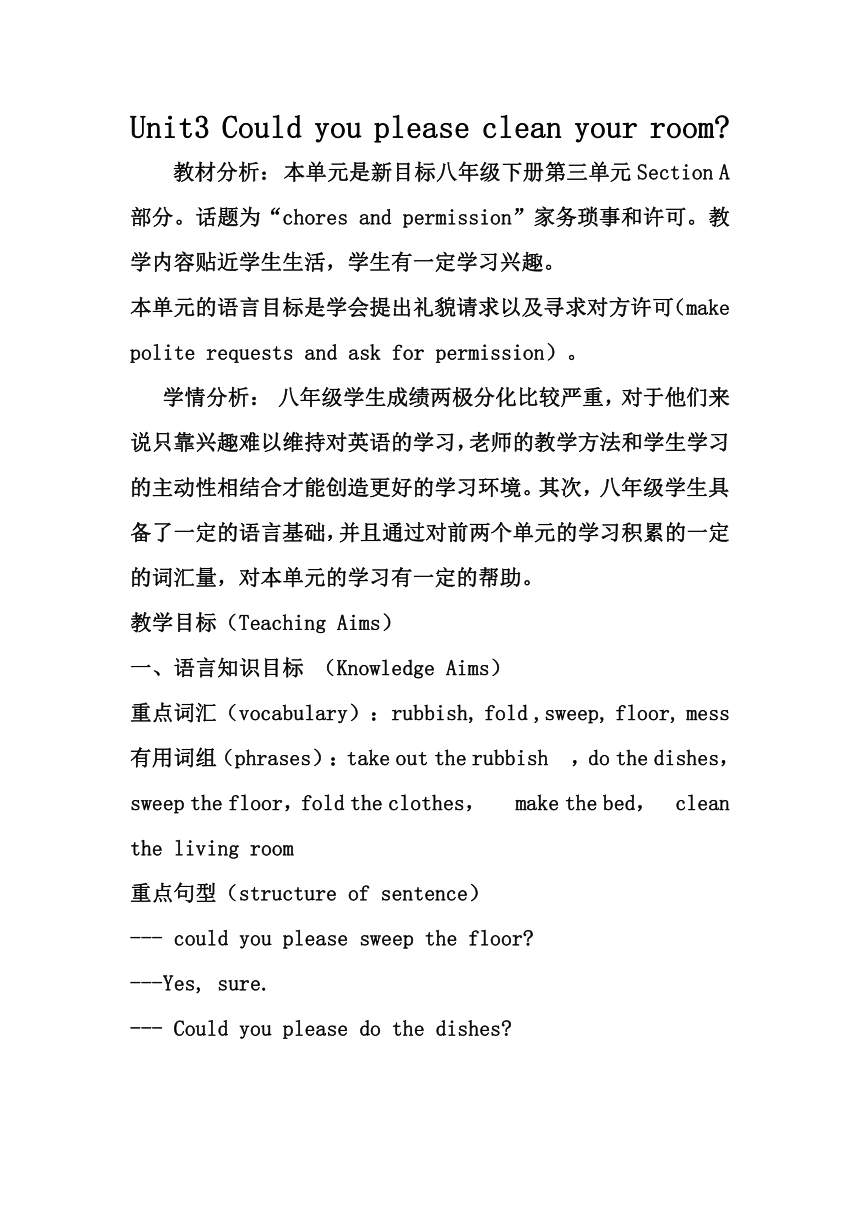
|
|
| 格式 | zip | ||
| 文件大小 | 44.5KB | ||
| 资源类型 | 教案 | ||
| 版本资源 | 人教新目标(Go for it)版 | ||
| 科目 | 英语 | ||
| 更新时间 | 2022-03-02 15:53:26 | ||
图片预览

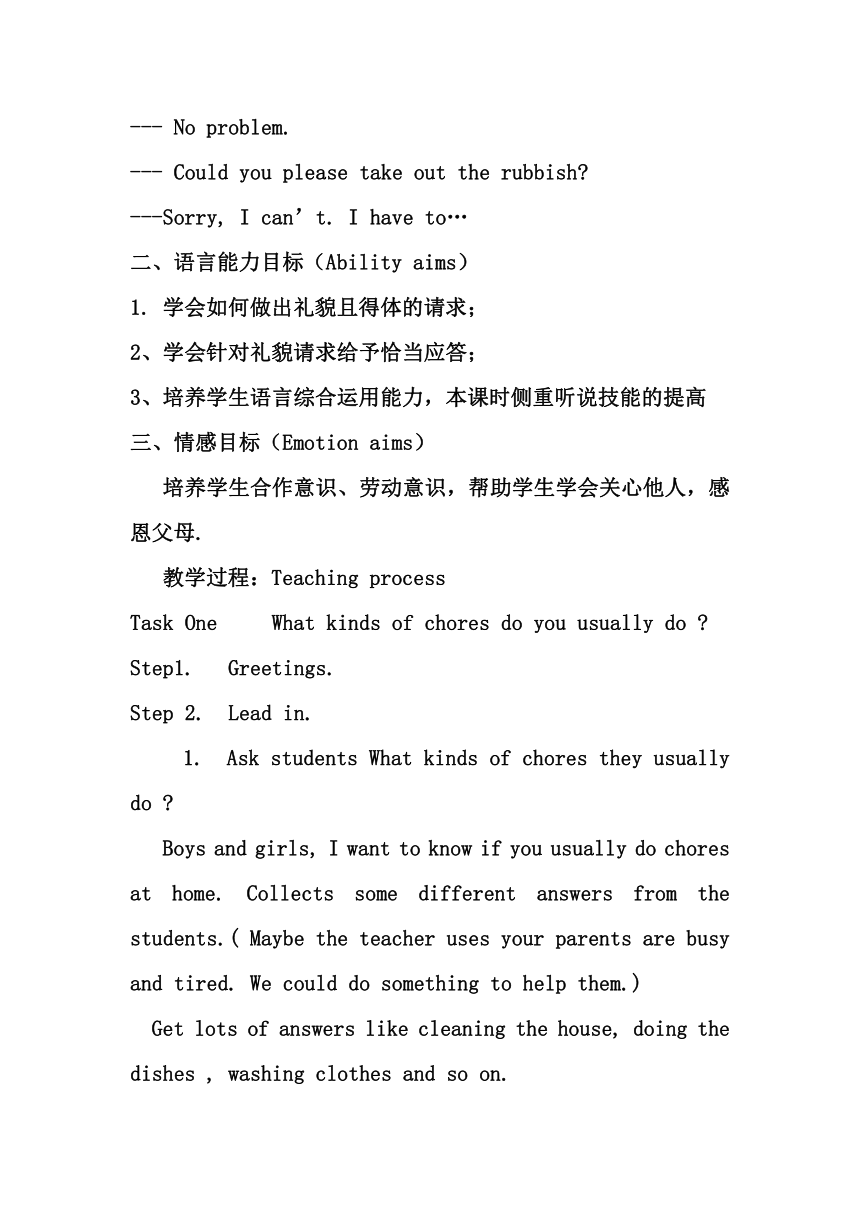
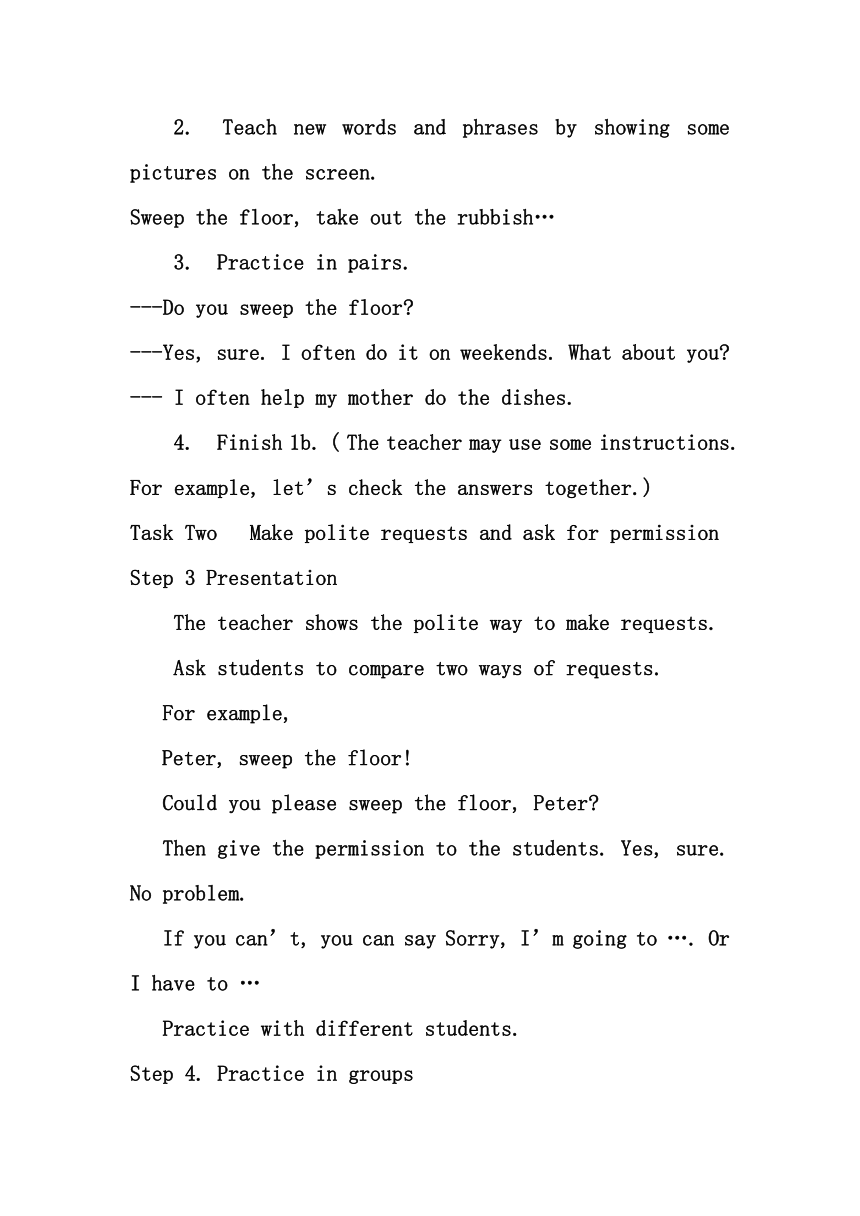
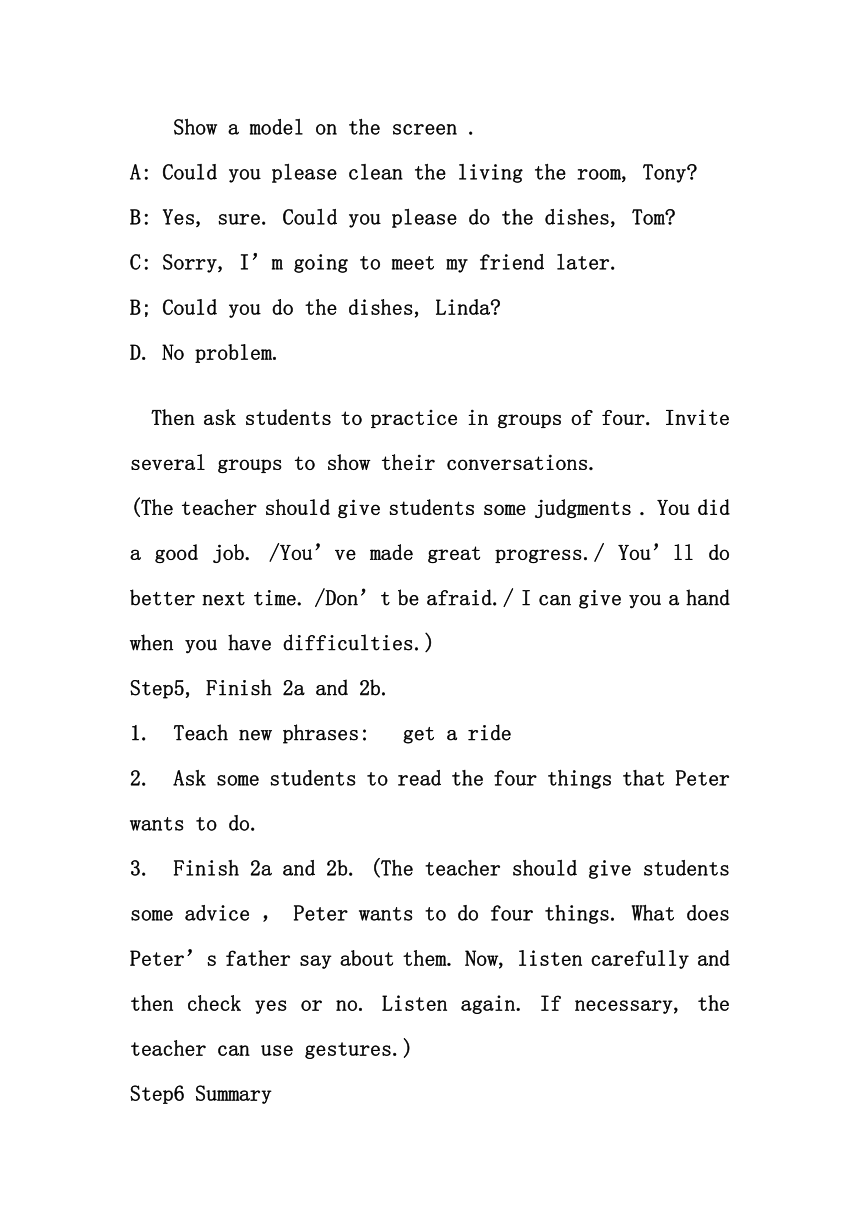
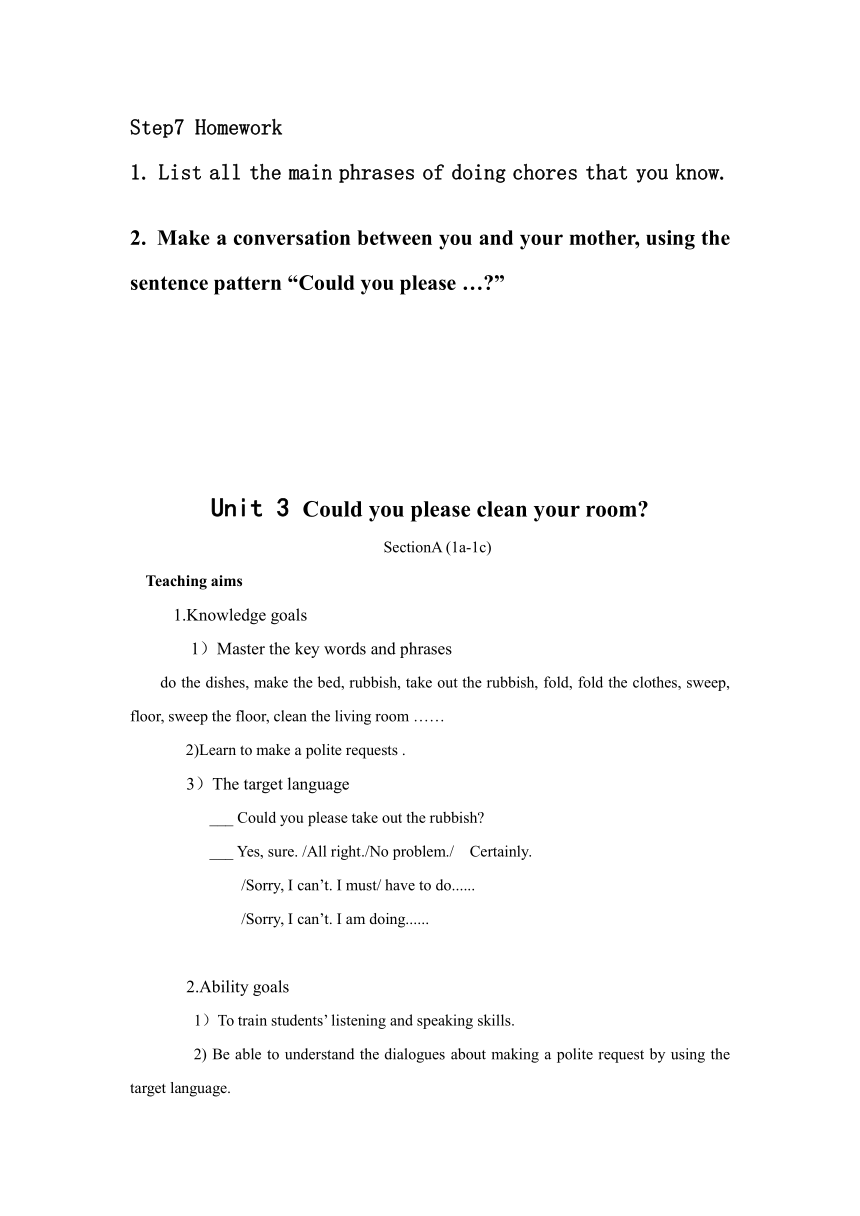
文档简介
Unit3 Could you please clean your room
教材分析: 本单元是新目标八年级下册第三单元Section A 部分。话题为“chores and permission”家务琐事和许可。教学内容贴近学生生活,学生有一定学习兴趣。
本单元的语言目标是学会提出礼貌请求以及寻求对方许可(make polite requests and ask for permission)。
学情分析: 八年级学生成绩两极分化比较严重,对于他们来说只靠兴趣难以维持对英语的学习,老师的教学方法和学生学习的主动性相结合才能创造更好的学习环境。其次,八年级学生具备了一定的语言基础,并且通过对前两个单元的学习积累的一定的词汇量,对本单元的学习有一定的帮助。
教学目标(Teaching Aims)
一、语言知识目标 (Knowledge Aims)
重点词汇(vocabulary):rubbish, fold ,sweep, floor, mess
有用词组(phrases):take out the rubbish ,do the dishes, sweep the floor,fold the clothes, make the bed, clean the living room
重点句型(structure of sentence)
--- could you please sweep the floor
---Yes, sure.
--- Could you please do the dishes
--- No problem.
--- Could you please take out the rubbish
---Sorry, I can’t. I have to…
二、语言能力目标(Ability aims)
1. 学会如何做出礼貌且得体的请求;
2、学会针对礼貌请求给予恰当应答;
3、培养学生语言综合运用能力,本课时侧重听说技能的提高
三、情感目标(Emotion aims)
培养学生合作意识、劳动意识,帮助学生学会关心他人,感恩父母.
教学过程:Teaching process
Task One What kinds of chores do you usually do
Step1. Greetings.
Step 2. Lead in.
1. Ask students What kinds of chores they usually do
Boys and girls, I want to know if you usually do chores at home. Collects some different answers from the students.( Maybe the teacher uses your parents are busy and tired. We could do something to help them.)
Get lots of answers like cleaning the house, doing the dishes , washing clothes and so on.
2. Teach new words and phrases by showing some pictures on the screen.
Sweep the floor, take out the rubbish…
3. Practice in pairs.
---Do you sweep the floor
---Yes, sure. I often do it on weekends. What about you
--- I often help my mother do the dishes.
4. Finish 1b. ( The teacher may use some instructions. For example, let’s check the answers together.)
Task Two Make polite requests and ask for permission
Step 3 Presentation
The teacher shows the polite way to make requests.
Ask students to compare two ways of requests.
For example,
Peter, sweep the floor!
Could you please sweep the floor, Peter
Then give the permission to the students. Yes, sure. No problem.
If you can’t, you can say Sorry, I’m going to …. Or I have to …
Practice with different students.
Step 4. Practice in groups
Show a model on the screen .
A: Could you please clean the living the room, Tony
B: Yes, sure. Could you please do the dishes, Tom
C: Sorry, I’m going to meet my friend later.
B; Could you do the dishes, Linda
D. No problem.
Then ask students to practice in groups of four. Invite several groups to show their conversations.
(The teacher should give students some judgments . You did a good job. /You’ve made great progress./ You’ll do better next time. /Don’t be afraid./ I can give you a hand when you have difficulties.)
Step5, Finish 2a and 2b.
1. Teach new phrases: get a ride
2. Ask some students to read the four things that Peter wants to do.
3. Finish 2a and 2b. (The teacher should give students some advice , Peter wants to do four things. What does Peter’s father say about them. Now, listen carefully and then check yes or no. Listen again. If necessary, the teacher can use gestures.)
Step6 Summary
Step7 Homework
1. List all the main phrases of doing chores that you know.
Make a conversation between you and your mother, using the sentence pattern “Could you please … ”
Unit 3 Could you please clean your room
SectionA (1a-1c)
Teaching aims
1.Knowledge goals
1)Master the key words and phrases
do the dishes, make the bed, rubbish, take out the rubbish, fold, fold the clothes, sweep, floor, sweep the floor, clean the living room ……
2)Learn to make a polite requests .
3)The target language
___ Could you please take out the rubbish
___ Yes, sure. /All right./No problem./ Certainly.
/Sorry, I can’t. I must/ have to do......
/Sorry, I can’t. I am doing......
2.Ability goals
1)To train students’ listening and speaking skills.
2) Be able to understand the dialogues about making a polite request by using the target language.
3. Emotional goals
1) Lead the students’ to know that it’s always right to be polite.
2)let students know that they should help their parents do chores at home ,to be a good helper.
Teaching important and difficult points
1)Master the key words and the target language.
2)To train students’ listening and speaking skills.
3) Enable students to understand the dialogues about making a polite request by using the target language.
Teaching methods
Multimedia method, pairwork , groupwork
Teaching procedures
Step I Lead-in
Let the students enjoy the video.
Step II Presentation
1. Learn the new words
1) Show students the pictures and help students to understand the new words.
2) Memory test. To try to remember the pictures in order.
3) Let students say out other chores and show some pictures.
4) Activity 1a.
2. Present the new sentence pattern.
Could you please...
(Help students answer it with “Yes , sure/No problem/All right/Certainly./Sorry, I can’t. I must/ have to do....../Sorry, I can’t. I am doing...... Ask several students to answer.)
Step III Consolidation
Look at the pictures. The teacher ask, students answer.
T: Could you please ……
Ss: Yes, sure./Ok/No problem./Certainly.
Sorry, /Sorry, I can’t. I must/ have to do......
/Sorry, I can’t. I am doing......
Step IV Listening
1.1b Listen. Who will do these chores Check (√) Peter’s mother or Peter.
Chores Peter’s mother Peter
do the dishes
sweep the floor
take out the rubbish
make the bed
fold the clothes
clean the living room
2. Listen again and fill in the blank.
3. Read together.
Step V 1C Pairwork
Make conversations about the chores in 1a.
Examples
A: Could you please...
B: Yes, sure. /All right. /No problem./Certainly.
Sorry, I can't. I have to do...
Sorry, I can't. I am doing...
Step VI Groupwork
A group of four make conversations. (They play the roles of father, mother ,grandmother and Peter.)
Step VII Summary
Summarize what they’ve learned. (Ask several students to summarize this class. After it , Ask them to read the summary.
Step VIII Exercises.
Step IX Homework.
1. List all the main phrases of doing chores that you know.
2. Make a conversation between you and your mother, using the sentence “Could you please … ”
Blackboard Design
Unit 3 Could you please clean your room
Section A (1a-1c)
___ Could you please take out the rubbish
___ Yes, sure. / All right. /No problem. / Certainly.
/Sorry, I can’t. I must/ have to do......
/Sorry, I can’t. I am doing......
Unit 3 Could you please clean your room
Section A (3a-3c)
一、教学目标:
1. 语言知识目标:
1) 能掌握以下单词和短语:neither,shirt,throw down,in surprise,all day and all evening,come over.
能更熟练掌握以下句型:
Could for polite requests:
— Could you please …
— Yes, sure./All right./No problem.
Sorry, I can’t. I have to…/I’m …
Could for permission :
— Could I …
— Yes, you can./No, you can’t.
2) 能读懂短文并会做相关练习;能够理解文中词语并进行写的训练。
2. 情感态度价值观目标:
在授课过程中渗透学生平时要多做家务,帮家人分担家务的情感目标,使学生在听读故事以及自己的表演中能意识到做家务的累,理解父母的辛苦,培养学生为他人着想,主动为他人分担的优良品质。
二、教学重难点
1. 教学重点:
1) 掌握这些短语动词的构成和用法:neither,shirt,throw down,in surprise,all day and all evening,come over.
2) 对提出有礼貌的请求和征求允许的句型以及如何礼貌应答进一步巩固练习。 Could for polite requests:
— Could you please …
— Yes, sure./All right./No problem.
Sorry, I can’t. I have to…/I’m …
Could for permission :
— Could I …
— Yes, you can./No, you can’t.
2. 教学难点:
对提出有礼貌的请求和征求允许的句型以及如何礼貌应答进行总结。
教学步骤
Step 1.Revision
1.Revise some phrases about housework.
2.Revise two drills about polite requests and permission.
Could for polite requests:
— Could you please …
— Yes, sure./All right./No problem.
Sorry, I can’t. I have to…/I’m …
Could for permission :
— Could I …
— Yes, you can./No, you can’t.
Step 2.Presentation
1.Free talk about housework.
2.Show a picture of Nancy’s house.
Step 3.Before-reading
Look at the picture,guess the answers to the questions.
1.Is the house clean and tidy,or is it a mess
2.Does she like doing chores at home
Step 4.While-reading
1.Skim the story,answer two questions.
2.Scan the story,answer some questions to know the details of the story.
3.Read after the mp3,try to master some important phrases.
throw down,take the dog for a walk,all day and all evening,
come over,all the time,in surprise,walk away,shout back,neither of,
help out around the house
4.Complete the mind-map to better understand the story.
Step 5.After-reading
1.Work on 3b.Check answers and try to make some sentences with the important words or phrases.
2.Work on 3c.Explain the title,check answers and make their own sentences.
Step 6.Role- play
Role-play this story,prepare for a few minutes and choose three groups to act it out in front of the class.
Step 7.Summary
Review some important phrases and sentences in this lesson.
1. Key vocabulary
throw down, come over, as tired as,
shout back, take the dog for a walk,
watch one show, all the time, the next day,
neither did I,in surprise
2. Important sentences
The minute I sat down in front of the TV, my mom came over.
For one week, she did not do any housework, and neither did I.
I’m just as tired as you are!
She asked in surprise.
年级 八年级 学科 英语 课题 Unit3 Could you please clean your room Section A (1a -1c)
教 材 分 析 本课时使用的是人教版新目标英语八年级下册 Unit 3 Could you please clean your classroom 单元中 Section A 1a-1c 的内容。本单元的话题是谈论家务琐事和家庭互助。家庭生活是学生生活的重要组成部分,对学生行为习惯的养成及责任感的建立起着重要的作用。因此,从话题角度上看,这一单元在本学期以及整个初中阶段的教学中具有特殊的地位和重要性。作为本单元的第一课时,主要任务是通过学生主动的学习和探究,掌握六个与家务劳动有关的短语,并能使用“Could you please do sth... ”这一句型有礼貌地提出请求。话题贴近学生生活,容易调动起学生的好奇心和求知欲,有利于引导他们自主学习。同时,潜移默化地对学生进行了礼仪教育和感恩教育,于教学之中体现了情感态度和德育目标。
学 习 者 分 析 本班共58名同学,是一个团结的班级体,学生都很积极,也很阳光。通过一年多的学习,学生们对英语的学习产生了极大的兴趣。英语基础知识相对扎实,这也就很容易激发学生学习的兴趣。因此,在课堂中,我多采用情景教学,让学生真正参与到活动中来,感受学习英语的乐趣。
设 计 理 念 在新课程目标的指导下,对现在的教师有了更高的要求。在教学活动中,要体现出学生的主体地位,教师的指导作用,要求教师将课堂回归给学生,让学生在乐中学。教学活动要使学生通过探究,小组合作,讨论,观察等学习方法,自主发现问题,并寻找解决问题的办法。在不断地发现与总结中提升自己的能力,从而使学生达到会学英语的目的,并提升学习英语的能力。
教 学 目 标 一、知识与技能 1. 认识并熟练运用有关家务的短语 clean the living room,sweep the floor,make the bed ,fold the clothes,do the dishes,take out the rubbish。 2. 掌握重点句型 Could you please... 3. 能使用所学短语及句型,表达礼貌委婉的请求
二、过程与方法 1. 通过创设情景,唱歌的方式,引出本节课重点,表达礼貌的请求 2. 课堂中,通过教师设置任务,学生在引导下自主进行探索学习。通过听和说的练习,完成本课的教学任务。
三、情感态度与价值观 1.在人际交往中学会使用礼貌用语,提高自身修养。 2.帮助学生树立主动承担家务的意识,渗透对父母的爱与感恩,做一个有家庭和社会责任感的新时代青少年
重 点 、 难 点 教学重点 1. 掌握重点单词及句型 2. 正确表达礼貌的请求 教学难点 正确表达礼貌的请求
渗透法制教 育 在教学教学的总结部分,用桃心形状融入法制教育。通过本堂课,教育学生学会感恩,学会帮助,学会承担责任,做一名合格的中学生。
教学方法 1. 情景教学法 2. 任务型教学法 3. 小组合作探究法
学 法 指 导 1.通过利用歌曲及图片创设情景,引导学生在真实的情景中大胆地开口说英语。 2. 通过不同的任务活动,让每位学生都积极参与其中,通过不断地听说练习,充分地让学生动起来,做到心动、口动
学习 准备 教师准备: PPT, 听力音频材料,歌曲
教学程序:《Period 1 Section A (1a - 1c)》 教学活动过程设计
教学步骤 用时 创设 情境 教师活动 学生活动 课堂 简评
Step 1 课前 热身 准备 2分钟 导入 学习 情景 1.Greetings to students. 2.用Can you help me…的句型创设情境,再引导学生观察教室,开门见山地引入目标句型Could you please.... 学生与老师相互问好,以便学生能快速地回到课堂学习中。 学生兴趣浓厚,激情饱满,乐于其中。
Step 2 走进 主题 学习 Step 2 走进 主题 学习 完 8分钟 探究 学习 1.用讨论的形式,一起唱歌曲“常回家看看”,再引出问题Do you often do chores at home 自然地过渡到新短语的学习 2.用做动作,猜短语的肢体语言游戏,巩固新短语 3.用PPT 展现课本 1a 的内容(单词,图片,对话),引出句型:Could you please.... 1.各个小组长组织组员进行讨论。 2.在游戏中。各小组进行比赛。 在活动中,人人参与其中,讨论激烈。 Pretty good!
. a 4分钟 对话 训练 (游戏) 通过1a的短语及句型,进行对话训练 One possible vision S1: Could you please.sweeep the floor S2: Sure. 1.学生积极参与展示每组派组员进行表演,进行对话。 2.在展示过程中,其他同学进行正确跟读 在展示过程中全班进行跟读,有利于提高听和说的能力。
8分钟 进行听力 训练 1.用图片中Peter的家务事,带学生进入听力练习 2.听力分为三部分: 听前熟悉要求;听中完成练习;听后跟读。 教师播放听力材料,请学生完成课本1b的任务(听力材料播放三遍:第一遍,学生听;第二遍,学生做;第三遍,学生跟着复述并核对答案。) 学生在听力中积极表现,在听后,各小组进行对话练习。 学生积极地投入到听力的训练中,准确度非常的高; Well down!
5分钟 展示 汇报 1.分组上台汇报。将听力结果依次板书在电子白板上。 2.请其他同学进行核对,教师也参与其中,在教室里巡回,检查各组情况,给与相应的指导。 在组内讨论后,组员代表积极展示各组的成果。 展示者积极踊跃,在活动中其乐融融。 Great!
Step 3 探究 8分钟 创设 探究 情景 1.探究Could引导的一般疑问句及答语 2.通过展现Kimi 和Shitou的生活习惯,引出句型及不同答语,进行总结 1.学生发挥小组合作能力,进行句型探究。 2.学生积极展示。 取得了非常好的效果。
Step 4 交际训练 5分钟 创设 交际 情景 PPT展示课本 1c 对话,引导学生在小组里进行讨论,根据示例进行对话。同时,鼓励学生进行创新性的对话案例: A: Could you please sweep the floor B:Yes,sure.Can you do the dishes A: Well, could you please do them I’m going to clean the living room. B: No problem. 2.组织学生上台带有感情地展现对话。 学生积极展现 学生在对话中不断创新,非常棒
Step 5 总结 归纳 4分钟 进行 反思 1.以字母引出单词,再用单词到短语,最后由短语到句子 2.学生依次进行总结 3.引出感恩教育 各小组积极展示成果并做相应补充。 各组表现积极
Step 6 作业 布置 巩固 提升 1分钟 1.Review the new words and target language by heart. 2.Help your mother do some housework and write down your feelings. 环节说明: 为更好地提高教学,满足不同层次学生的需要,实行分层次布置作业。
板 书 设 计 Unit 3 Could you please clean your room Section A 1a -1c Key words rubbish, fold, sweep, floor , take out the rubbish Sentences: —Peter, could you please clean your room ----Sure, Mom.
课 后 体 会 反 思 本节课采用了情景交际与任务型相结合、小组合作的方式,很好地完成了教学。也使我深深地体会到一节课成功的关键所在,为此,我做出了一下反思: 良好的教学效果不仅要做到课前认真备课是,还要具备课堂组织的能力。最后,要由心动到行动。 本课的安排是让学生从心动主动到行动的学习来安排教学。这是一堂听说课,在教学之初,用歌曲激起学生的兴趣,使学生心动,从而更好地进入学习。其次,在教学过程中,通过游戏表演,活动及小组间地不断探究,引导学生利用目标语言来谈论家务活动。最后,通过知识的总结,引出感恩教育,丰富了教学内容。在教师的抛砖引玉、学生的自主学习下,很好地完成了本节课的教学目标。 但是,人非圣贤,孰能无过。在今后的教学中,我会更加认真地钻研每一堂课,把课堂返回给学生,做好课堂的驾驭者和引导者,体会教与学的乐趣。
所教年级 八年级 所教册次、 单元 八年级下册Unit3 Could you please clean your room Section A 3a-3c
1.教学背景分析
教学内容分析: 本单元主题将焦点聚集在家庭生活上,谈论教务琐事及家庭互助。家庭生活和家务劳动是社会家庭和学生生活中的重要方面,对学生生活习惯的养成,社会行为习惯及家庭情感的建立起着重要的作用。因此,从话题角度上看,这一单元在本学期乃至整个初中英语教学中具有特殊的地位和重要性。从功能及语言结构方面来看,Section A部分教学结束时,学生应当能够用情态动词Could征询许可及礼貌地提出要求。 3a-3c通过阅读强化对单元主题内容及语言项目的学习及理解,发展学生的阅读技能,在联系活动的设计上紧密联系上一单元的阅读策略,进一步巩固、强化学生对词性的辨识及运用。 学生情况分析: 通过第一课时的学习,学生已经初步感知了Could用于礼貌提出要求和征询许可的语用功能,并能用Could句型进行简短的小对话问答。但是对于该句型在日常生活中的使用还是缺乏语境感知,停留在对话层次。所以本课时的教学活动尽量从语境入手,让学生参与到阅读中来,在语篇情境中感知和进一步使用目标语言。
2.教学目标分析
语言技能目标:学生能够通过运用Could来礼貌地提出要求和征询许可。 语言知识目标:学生能够掌握并熟练运用有关家务话题的语言。 情感态度目标:学生通过学习,能够养成良好的生活习惯,对独立承担或帮助父母做适当的家务持有积极的态度。 文化意识目标:学生能够了解西方家庭中狗作为家庭成员的背景文化。 学习策略目标:学生能够运用wh-法对故事性文本进行解读;运用词性辨析的方法,对词汇进行分析和运用。
3.教学重点、难点分析
教学重点:学会运用目标语言来礼貌地提出要求和征询许可。 教学难点:能够感知文章中不同的语言表达带来的语气和情绪上的变化。
4.教学过程设计
步骤1:Lead-in (1) Free talk about the picture. 设计意图:就文本中的插图进行读图活动,快速进入家务的话题,师生间就家务进行交流:你们家是谁做家务,你会帮助父母做家务吗等,来激活学生思维,为本课所谈论的话题做好了充分的准备。 (2) What do you want to know about the story? 设计意图:本课中教师将与学生分享一个有关家务的故事,学生对于story可能有自己的关注点,因此在阅读之前,让学生来说说他们想了解什么,如:我想知道故事发生的时间、我想知道故事的结局等。这样可以在读前了解学生的关注点,同时激发学生对文本进行探究的兴趣。 步骤2:First reading Try to find the answers you want to know. 设计意图:第一遍阅读,让学生对上一环节中的提问进行有目的的阅读。同时学生对文本有了大概的了解。在这一环节中,解决了when/where/who的问题,学生对于dog作为西方家庭成员的文化背景有了基本了解。 步骤3:Second reading What happened between Nancy and her mom? 设计意图:第二遍阅读,学生要着重去寻找what的答案。在分析过程中,用图表的形式帮助学生对故事情节进行串联。Nancy was tired-She didn’t walk the dog at once-They argued-No one did the housework-Nancy said sorry and cleaned the house 步骤4:Third reading Try to answer some questions about the story. 设计意图:第三遍阅读,分别针对5个故事环节进行提问: Try to find some actions or words that can show Nancy was tired. Try to find the words that can show mom was angry. How did Nancy feel How did mom feel then What happened after the fight How did they solve the problem 步骤5:Group work Role-play the story with your partners. Mom/Nancy/Narrator 设计意图:学生在学习完Nancy的故事以后,只是停留在对别人故事的感知,对语气和语言表达需要进行进一步体验。所以这一环节的设置自然水到渠成,学生要结合对文本人物的揣摩和语言的表达,进行角色的扮演,在这过程中,融合了肢体语言,情感表达和学生的表演欲望。 步骤6:Exercise Finish 3b together. 设计意图:因为这三个句子在文本中学生进行了反复的阅读和表达运用,因此这个练习的完成就很顺利,不需要老师过多的解释,文本的语境就是最好的感知。 Finish Exercise 3c 设计意图:本环节,学生延续了上一单元的词汇学习策略,进一步学习词汇的辨析和运用。教师在文本分析中对walk这一次的运用埋下了伏笔,所以以walk的使用着手进行分析,再推进这个练习。 步骤8:Homework 1. Think of more words that can be used both as nouns and verbs. 2. Show the story with your partner. 设计意图:课堂上因为时间限制,学生只能完成3c所提供的几个词汇,所以课后进一步的思考和拓展是对此次训练的加强。故事的分享旨在给学生更多的表演空间,让学生尽量脱离课本,对故事有更多新的演绎。
教材分析: 本单元是新目标八年级下册第三单元Section A 部分。话题为“chores and permission”家务琐事和许可。教学内容贴近学生生活,学生有一定学习兴趣。
本单元的语言目标是学会提出礼貌请求以及寻求对方许可(make polite requests and ask for permission)。
学情分析: 八年级学生成绩两极分化比较严重,对于他们来说只靠兴趣难以维持对英语的学习,老师的教学方法和学生学习的主动性相结合才能创造更好的学习环境。其次,八年级学生具备了一定的语言基础,并且通过对前两个单元的学习积累的一定的词汇量,对本单元的学习有一定的帮助。
教学目标(Teaching Aims)
一、语言知识目标 (Knowledge Aims)
重点词汇(vocabulary):rubbish, fold ,sweep, floor, mess
有用词组(phrases):take out the rubbish ,do the dishes, sweep the floor,fold the clothes, make the bed, clean the living room
重点句型(structure of sentence)
--- could you please sweep the floor
---Yes, sure.
--- Could you please do the dishes
--- No problem.
--- Could you please take out the rubbish
---Sorry, I can’t. I have to…
二、语言能力目标(Ability aims)
1. 学会如何做出礼貌且得体的请求;
2、学会针对礼貌请求给予恰当应答;
3、培养学生语言综合运用能力,本课时侧重听说技能的提高
三、情感目标(Emotion aims)
培养学生合作意识、劳动意识,帮助学生学会关心他人,感恩父母.
教学过程:Teaching process
Task One What kinds of chores do you usually do
Step1. Greetings.
Step 2. Lead in.
1. Ask students What kinds of chores they usually do
Boys and girls, I want to know if you usually do chores at home. Collects some different answers from the students.( Maybe the teacher uses your parents are busy and tired. We could do something to help them.)
Get lots of answers like cleaning the house, doing the dishes , washing clothes and so on.
2. Teach new words and phrases by showing some pictures on the screen.
Sweep the floor, take out the rubbish…
3. Practice in pairs.
---Do you sweep the floor
---Yes, sure. I often do it on weekends. What about you
--- I often help my mother do the dishes.
4. Finish 1b. ( The teacher may use some instructions. For example, let’s check the answers together.)
Task Two Make polite requests and ask for permission
Step 3 Presentation
The teacher shows the polite way to make requests.
Ask students to compare two ways of requests.
For example,
Peter, sweep the floor!
Could you please sweep the floor, Peter
Then give the permission to the students. Yes, sure. No problem.
If you can’t, you can say Sorry, I’m going to …. Or I have to …
Practice with different students.
Step 4. Practice in groups
Show a model on the screen .
A: Could you please clean the living the room, Tony
B: Yes, sure. Could you please do the dishes, Tom
C: Sorry, I’m going to meet my friend later.
B; Could you do the dishes, Linda
D. No problem.
Then ask students to practice in groups of four. Invite several groups to show their conversations.
(The teacher should give students some judgments . You did a good job. /You’ve made great progress./ You’ll do better next time. /Don’t be afraid./ I can give you a hand when you have difficulties.)
Step5, Finish 2a and 2b.
1. Teach new phrases: get a ride
2. Ask some students to read the four things that Peter wants to do.
3. Finish 2a and 2b. (The teacher should give students some advice , Peter wants to do four things. What does Peter’s father say about them. Now, listen carefully and then check yes or no. Listen again. If necessary, the teacher can use gestures.)
Step6 Summary
Step7 Homework
1. List all the main phrases of doing chores that you know.
Make a conversation between you and your mother, using the sentence pattern “Could you please … ”
Unit 3 Could you please clean your room
SectionA (1a-1c)
Teaching aims
1.Knowledge goals
1)Master the key words and phrases
do the dishes, make the bed, rubbish, take out the rubbish, fold, fold the clothes, sweep, floor, sweep the floor, clean the living room ……
2)Learn to make a polite requests .
3)The target language
___ Could you please take out the rubbish
___ Yes, sure. /All right./No problem./ Certainly.
/Sorry, I can’t. I must/ have to do......
/Sorry, I can’t. I am doing......
2.Ability goals
1)To train students’ listening and speaking skills.
2) Be able to understand the dialogues about making a polite request by using the target language.
3. Emotional goals
1) Lead the students’ to know that it’s always right to be polite.
2)let students know that they should help their parents do chores at home ,to be a good helper.
Teaching important and difficult points
1)Master the key words and the target language.
2)To train students’ listening and speaking skills.
3) Enable students to understand the dialogues about making a polite request by using the target language.
Teaching methods
Multimedia method, pairwork , groupwork
Teaching procedures
Step I Lead-in
Let the students enjoy the video.
Step II Presentation
1. Learn the new words
1) Show students the pictures and help students to understand the new words.
2) Memory test. To try to remember the pictures in order.
3) Let students say out other chores and show some pictures.
4) Activity 1a.
2. Present the new sentence pattern.
Could you please...
(Help students answer it with “Yes , sure/No problem/All right/Certainly./Sorry, I can’t. I must/ have to do....../Sorry, I can’t. I am doing...... Ask several students to answer.)
Step III Consolidation
Look at the pictures. The teacher ask, students answer.
T: Could you please ……
Ss: Yes, sure./Ok/No problem./Certainly.
Sorry, /Sorry, I can’t. I must/ have to do......
/Sorry, I can’t. I am doing......
Step IV Listening
1.1b Listen. Who will do these chores Check (√) Peter’s mother or Peter.
Chores Peter’s mother Peter
do the dishes
sweep the floor
take out the rubbish
make the bed
fold the clothes
clean the living room
2. Listen again and fill in the blank.
3. Read together.
Step V 1C Pairwork
Make conversations about the chores in 1a.
Examples
A: Could you please...
B: Yes, sure. /All right. /No problem./Certainly.
Sorry, I can't. I have to do...
Sorry, I can't. I am doing...
Step VI Groupwork
A group of four make conversations. (They play the roles of father, mother ,grandmother and Peter.)
Step VII Summary
Summarize what they’ve learned. (Ask several students to summarize this class. After it , Ask them to read the summary.
Step VIII Exercises.
Step IX Homework.
1. List all the main phrases of doing chores that you know.
2. Make a conversation between you and your mother, using the sentence “Could you please … ”
Blackboard Design
Unit 3 Could you please clean your room
Section A (1a-1c)
___ Could you please take out the rubbish
___ Yes, sure. / All right. /No problem. / Certainly.
/Sorry, I can’t. I must/ have to do......
/Sorry, I can’t. I am doing......
Unit 3 Could you please clean your room
Section A (3a-3c)
一、教学目标:
1. 语言知识目标:
1) 能掌握以下单词和短语:neither,shirt,throw down,in surprise,all day and all evening,come over.
能更熟练掌握以下句型:
Could for polite requests:
— Could you please …
— Yes, sure./All right./No problem.
Sorry, I can’t. I have to…/I’m …
Could for permission :
— Could I …
— Yes, you can./No, you can’t.
2) 能读懂短文并会做相关练习;能够理解文中词语并进行写的训练。
2. 情感态度价值观目标:
在授课过程中渗透学生平时要多做家务,帮家人分担家务的情感目标,使学生在听读故事以及自己的表演中能意识到做家务的累,理解父母的辛苦,培养学生为他人着想,主动为他人分担的优良品质。
二、教学重难点
1. 教学重点:
1) 掌握这些短语动词的构成和用法:neither,shirt,throw down,in surprise,all day and all evening,come over.
2) 对提出有礼貌的请求和征求允许的句型以及如何礼貌应答进一步巩固练习。 Could for polite requests:
— Could you please …
— Yes, sure./All right./No problem.
Sorry, I can’t. I have to…/I’m …
Could for permission :
— Could I …
— Yes, you can./No, you can’t.
2. 教学难点:
对提出有礼貌的请求和征求允许的句型以及如何礼貌应答进行总结。
教学步骤
Step 1.Revision
1.Revise some phrases about housework.
2.Revise two drills about polite requests and permission.
Could for polite requests:
— Could you please …
— Yes, sure./All right./No problem.
Sorry, I can’t. I have to…/I’m …
Could for permission :
— Could I …
— Yes, you can./No, you can’t.
Step 2.Presentation
1.Free talk about housework.
2.Show a picture of Nancy’s house.
Step 3.Before-reading
Look at the picture,guess the answers to the questions.
1.Is the house clean and tidy,or is it a mess
2.Does she like doing chores at home
Step 4.While-reading
1.Skim the story,answer two questions.
2.Scan the story,answer some questions to know the details of the story.
3.Read after the mp3,try to master some important phrases.
throw down,take the dog for a walk,all day and all evening,
come over,all the time,in surprise,walk away,shout back,neither of,
help out around the house
4.Complete the mind-map to better understand the story.
Step 5.After-reading
1.Work on 3b.Check answers and try to make some sentences with the important words or phrases.
2.Work on 3c.Explain the title,check answers and make their own sentences.
Step 6.Role- play
Role-play this story,prepare for a few minutes and choose three groups to act it out in front of the class.
Step 7.Summary
Review some important phrases and sentences in this lesson.
1. Key vocabulary
throw down, come over, as tired as,
shout back, take the dog for a walk,
watch one show, all the time, the next day,
neither did I,in surprise
2. Important sentences
The minute I sat down in front of the TV, my mom came over.
For one week, she did not do any housework, and neither did I.
I’m just as tired as you are!
She asked in surprise.
年级 八年级 学科 英语 课题 Unit3 Could you please clean your room Section A (1a -1c)
教 材 分 析 本课时使用的是人教版新目标英语八年级下册 Unit 3 Could you please clean your classroom 单元中 Section A 1a-1c 的内容。本单元的话题是谈论家务琐事和家庭互助。家庭生活是学生生活的重要组成部分,对学生行为习惯的养成及责任感的建立起着重要的作用。因此,从话题角度上看,这一单元在本学期以及整个初中阶段的教学中具有特殊的地位和重要性。作为本单元的第一课时,主要任务是通过学生主动的学习和探究,掌握六个与家务劳动有关的短语,并能使用“Could you please do sth... ”这一句型有礼貌地提出请求。话题贴近学生生活,容易调动起学生的好奇心和求知欲,有利于引导他们自主学习。同时,潜移默化地对学生进行了礼仪教育和感恩教育,于教学之中体现了情感态度和德育目标。
学 习 者 分 析 本班共58名同学,是一个团结的班级体,学生都很积极,也很阳光。通过一年多的学习,学生们对英语的学习产生了极大的兴趣。英语基础知识相对扎实,这也就很容易激发学生学习的兴趣。因此,在课堂中,我多采用情景教学,让学生真正参与到活动中来,感受学习英语的乐趣。
设 计 理 念 在新课程目标的指导下,对现在的教师有了更高的要求。在教学活动中,要体现出学生的主体地位,教师的指导作用,要求教师将课堂回归给学生,让学生在乐中学。教学活动要使学生通过探究,小组合作,讨论,观察等学习方法,自主发现问题,并寻找解决问题的办法。在不断地发现与总结中提升自己的能力,从而使学生达到会学英语的目的,并提升学习英语的能力。
教 学 目 标 一、知识与技能 1. 认识并熟练运用有关家务的短语 clean the living room,sweep the floor,make the bed ,fold the clothes,do the dishes,take out the rubbish。 2. 掌握重点句型 Could you please... 3. 能使用所学短语及句型,表达礼貌委婉的请求
二、过程与方法 1. 通过创设情景,唱歌的方式,引出本节课重点,表达礼貌的请求 2. 课堂中,通过教师设置任务,学生在引导下自主进行探索学习。通过听和说的练习,完成本课的教学任务。
三、情感态度与价值观 1.在人际交往中学会使用礼貌用语,提高自身修养。 2.帮助学生树立主动承担家务的意识,渗透对父母的爱与感恩,做一个有家庭和社会责任感的新时代青少年
重 点 、 难 点 教学重点 1. 掌握重点单词及句型 2. 正确表达礼貌的请求 教学难点 正确表达礼貌的请求
渗透法制教 育 在教学教学的总结部分,用桃心形状融入法制教育。通过本堂课,教育学生学会感恩,学会帮助,学会承担责任,做一名合格的中学生。
教学方法 1. 情景教学法 2. 任务型教学法 3. 小组合作探究法
学 法 指 导 1.通过利用歌曲及图片创设情景,引导学生在真实的情景中大胆地开口说英语。 2. 通过不同的任务活动,让每位学生都积极参与其中,通过不断地听说练习,充分地让学生动起来,做到心动、口动
学习 准备 教师准备: PPT, 听力音频材料,歌曲
教学程序:《Period 1 Section A (1a - 1c)》 教学活动过程设计
教学步骤 用时 创设 情境 教师活动 学生活动 课堂 简评
Step 1 课前 热身 准备 2分钟 导入 学习 情景 1.Greetings to students. 2.用Can you help me…的句型创设情境,再引导学生观察教室,开门见山地引入目标句型Could you please.... 学生与老师相互问好,以便学生能快速地回到课堂学习中。 学生兴趣浓厚,激情饱满,乐于其中。
Step 2 走进 主题 学习 Step 2 走进 主题 学习 完 8分钟 探究 学习 1.用讨论的形式,一起唱歌曲“常回家看看”,再引出问题Do you often do chores at home 自然地过渡到新短语的学习 2.用做动作,猜短语的肢体语言游戏,巩固新短语 3.用PPT 展现课本 1a 的内容(单词,图片,对话),引出句型:Could you please.... 1.各个小组长组织组员进行讨论。 2.在游戏中。各小组进行比赛。 在活动中,人人参与其中,讨论激烈。 Pretty good!
. a 4分钟 对话 训练 (游戏) 通过1a的短语及句型,进行对话训练 One possible vision S1: Could you please.sweeep the floor S2: Sure. 1.学生积极参与展示每组派组员进行表演,进行对话。 2.在展示过程中,其他同学进行正确跟读 在展示过程中全班进行跟读,有利于提高听和说的能力。
8分钟 进行听力 训练 1.用图片中Peter的家务事,带学生进入听力练习 2.听力分为三部分: 听前熟悉要求;听中完成练习;听后跟读。 教师播放听力材料,请学生完成课本1b的任务(听力材料播放三遍:第一遍,学生听;第二遍,学生做;第三遍,学生跟着复述并核对答案。) 学生在听力中积极表现,在听后,各小组进行对话练习。 学生积极地投入到听力的训练中,准确度非常的高; Well down!
5分钟 展示 汇报 1.分组上台汇报。将听力结果依次板书在电子白板上。 2.请其他同学进行核对,教师也参与其中,在教室里巡回,检查各组情况,给与相应的指导。 在组内讨论后,组员代表积极展示各组的成果。 展示者积极踊跃,在活动中其乐融融。 Great!
Step 3 探究 8分钟 创设 探究 情景 1.探究Could引导的一般疑问句及答语 2.通过展现Kimi 和Shitou的生活习惯,引出句型及不同答语,进行总结 1.学生发挥小组合作能力,进行句型探究。 2.学生积极展示。 取得了非常好的效果。
Step 4 交际训练 5分钟 创设 交际 情景 PPT展示课本 1c 对话,引导学生在小组里进行讨论,根据示例进行对话。同时,鼓励学生进行创新性的对话案例: A: Could you please sweep the floor B:Yes,sure.Can you do the dishes A: Well, could you please do them I’m going to clean the living room. B: No problem. 2.组织学生上台带有感情地展现对话。 学生积极展现 学生在对话中不断创新,非常棒
Step 5 总结 归纳 4分钟 进行 反思 1.以字母引出单词,再用单词到短语,最后由短语到句子 2.学生依次进行总结 3.引出感恩教育 各小组积极展示成果并做相应补充。 各组表现积极
Step 6 作业 布置 巩固 提升 1分钟 1.Review the new words and target language by heart. 2.Help your mother do some housework and write down your feelings. 环节说明: 为更好地提高教学,满足不同层次学生的需要,实行分层次布置作业。
板 书 设 计 Unit 3 Could you please clean your room Section A 1a -1c Key words rubbish, fold, sweep, floor , take out the rubbish Sentences: —Peter, could you please clean your room ----Sure, Mom.
课 后 体 会 反 思 本节课采用了情景交际与任务型相结合、小组合作的方式,很好地完成了教学。也使我深深地体会到一节课成功的关键所在,为此,我做出了一下反思: 良好的教学效果不仅要做到课前认真备课是,还要具备课堂组织的能力。最后,要由心动到行动。 本课的安排是让学生从心动主动到行动的学习来安排教学。这是一堂听说课,在教学之初,用歌曲激起学生的兴趣,使学生心动,从而更好地进入学习。其次,在教学过程中,通过游戏表演,活动及小组间地不断探究,引导学生利用目标语言来谈论家务活动。最后,通过知识的总结,引出感恩教育,丰富了教学内容。在教师的抛砖引玉、学生的自主学习下,很好地完成了本节课的教学目标。 但是,人非圣贤,孰能无过。在今后的教学中,我会更加认真地钻研每一堂课,把课堂返回给学生,做好课堂的驾驭者和引导者,体会教与学的乐趣。
所教年级 八年级 所教册次、 单元 八年级下册Unit3 Could you please clean your room Section A 3a-3c
1.教学背景分析
教学内容分析: 本单元主题将焦点聚集在家庭生活上,谈论教务琐事及家庭互助。家庭生活和家务劳动是社会家庭和学生生活中的重要方面,对学生生活习惯的养成,社会行为习惯及家庭情感的建立起着重要的作用。因此,从话题角度上看,这一单元在本学期乃至整个初中英语教学中具有特殊的地位和重要性。从功能及语言结构方面来看,Section A部分教学结束时,学生应当能够用情态动词Could征询许可及礼貌地提出要求。 3a-3c通过阅读强化对单元主题内容及语言项目的学习及理解,发展学生的阅读技能,在联系活动的设计上紧密联系上一单元的阅读策略,进一步巩固、强化学生对词性的辨识及运用。 学生情况分析: 通过第一课时的学习,学生已经初步感知了Could用于礼貌提出要求和征询许可的语用功能,并能用Could句型进行简短的小对话问答。但是对于该句型在日常生活中的使用还是缺乏语境感知,停留在对话层次。所以本课时的教学活动尽量从语境入手,让学生参与到阅读中来,在语篇情境中感知和进一步使用目标语言。
2.教学目标分析
语言技能目标:学生能够通过运用Could来礼貌地提出要求和征询许可。 语言知识目标:学生能够掌握并熟练运用有关家务话题的语言。 情感态度目标:学生通过学习,能够养成良好的生活习惯,对独立承担或帮助父母做适当的家务持有积极的态度。 文化意识目标:学生能够了解西方家庭中狗作为家庭成员的背景文化。 学习策略目标:学生能够运用wh-法对故事性文本进行解读;运用词性辨析的方法,对词汇进行分析和运用。
3.教学重点、难点分析
教学重点:学会运用目标语言来礼貌地提出要求和征询许可。 教学难点:能够感知文章中不同的语言表达带来的语气和情绪上的变化。
4.教学过程设计
步骤1:Lead-in (1) Free talk about the picture. 设计意图:就文本中的插图进行读图活动,快速进入家务的话题,师生间就家务进行交流:你们家是谁做家务,你会帮助父母做家务吗等,来激活学生思维,为本课所谈论的话题做好了充分的准备。 (2) What do you want to know about the story? 设计意图:本课中教师将与学生分享一个有关家务的故事,学生对于story可能有自己的关注点,因此在阅读之前,让学生来说说他们想了解什么,如:我想知道故事发生的时间、我想知道故事的结局等。这样可以在读前了解学生的关注点,同时激发学生对文本进行探究的兴趣。 步骤2:First reading Try to find the answers you want to know. 设计意图:第一遍阅读,让学生对上一环节中的提问进行有目的的阅读。同时学生对文本有了大概的了解。在这一环节中,解决了when/where/who的问题,学生对于dog作为西方家庭成员的文化背景有了基本了解。 步骤3:Second reading What happened between Nancy and her mom? 设计意图:第二遍阅读,学生要着重去寻找what的答案。在分析过程中,用图表的形式帮助学生对故事情节进行串联。Nancy was tired-She didn’t walk the dog at once-They argued-No one did the housework-Nancy said sorry and cleaned the house 步骤4:Third reading Try to answer some questions about the story. 设计意图:第三遍阅读,分别针对5个故事环节进行提问: Try to find some actions or words that can show Nancy was tired. Try to find the words that can show mom was angry. How did Nancy feel How did mom feel then What happened after the fight How did they solve the problem 步骤5:Group work Role-play the story with your partners. Mom/Nancy/Narrator 设计意图:学生在学习完Nancy的故事以后,只是停留在对别人故事的感知,对语气和语言表达需要进行进一步体验。所以这一环节的设置自然水到渠成,学生要结合对文本人物的揣摩和语言的表达,进行角色的扮演,在这过程中,融合了肢体语言,情感表达和学生的表演欲望。 步骤6:Exercise Finish 3b together. 设计意图:因为这三个句子在文本中学生进行了反复的阅读和表达运用,因此这个练习的完成就很顺利,不需要老师过多的解释,文本的语境就是最好的感知。 Finish Exercise 3c 设计意图:本环节,学生延续了上一单元的词汇学习策略,进一步学习词汇的辨析和运用。教师在文本分析中对walk这一次的运用埋下了伏笔,所以以walk的使用着手进行分析,再推进这个练习。 步骤8:Homework 1. Think of more words that can be used both as nouns and verbs. 2. Show the story with your partner. 设计意图:课堂上因为时间限制,学生只能完成3c所提供的几个词汇,所以课后进一步的思考和拓展是对此次训练的加强。故事的分享旨在给学生更多的表演空间,让学生尽量脱离课本,对故事有更多新的演绎。
同课章节目录
- Unit 1 What's the matter?
- Section A
- Section B
- Unit 2 I'll help to clean up the city parks.
- Section A
- Section B
- Unit 3 Could you please clean your room?
- Section A
- Section B
- Unit 4 Why don't you talk to your parents?
- Section A
- Section B
- Unit 5 What were you doing when the rainstorm came
- Section A
- Section B
- Review of Units 1-5
- Unit 6 An old man tried to move the mountains.
- Section A
- Section B
- Unit 7 What's the highest mountain in the world?
- Section A
- Section B
- Unit 8 Have you read Treasure Island yet?
- Section A
- Section B
- Unit 9 Have you ever been to a museum?
- Section A
- Section B
- Unit 10 I've had this bike for three years.
- Section A
- Section B
